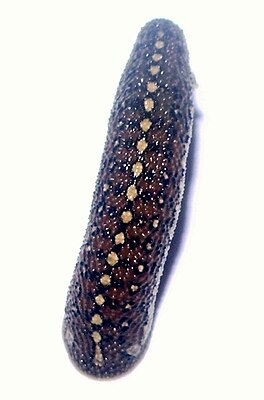Chain-streaked leech
| Chain-streaked leech | ||||||||||||
|---|---|---|---|---|---|---|---|---|---|---|---|---|

Chain-striped leech ( Phytobdella catenifera ) |
||||||||||||
| Systematics | ||||||||||||
|
||||||||||||
| Scientific name | ||||||||||||
| Phytobdella catenifera | ||||||||||||
| Moore , 1938 |
The chained leech ( Phytobdella catenifera ) is a species of landing leech (Haemadipsidae) that infects various reptiles as a blood- sucking parasite in the forests of the Malay Peninsula .
features
Like all members of the genus Phytobdella , Phytobdella catenifera has only two jaws (and not three like most jaws rule ), and there are six outer ringlets per segment, with 6 to 7 ringlets between the gonopores. The leech reaches a length of 5 cm, which is considerable for Langegel. The brown body has 3 to 5 black chain-shaped stripes on the back with light, black-edged spots, which are often particularly pronounced in the middle stripe. When preserved, the animal takes on a yellowish color. Phytobdella catenifera becomes about 13 to 33 mm long. The diameter of the front suction cup is about 1.3 to 2.5 mm, that of the rear 2.5 to 3.7 mm. The rear suction cup has 63 to 65 rays and only stunted or missing ears.
Distribution, habitat and way of life
The chained leech lives in the forests of the Malay Peninsula in Malaysia . It attacks reptiles and seems to completely disdain humans as hosts. The type specimen was collected together with 23 conspecifics from a brown tortoise ( Manouria emys ).
Reproductive cycle
Like other leech is the Kettstreifige leech a hybrid , as the Kieferegel a penis has. With mutual copulation, the sperm is transferred through the penis directly into the gonopore of the sex partner. The eggs are laid in a protective cocoon, where they develop into ready-made little leeches.
literature
- A. Soos: Identification key to the leech (Hirudinoidea) genera of the world with a catalog of the species. IV. Family: Haemadipsidae. Acta Zoologica Academiae Scientiarum Hungaricae 13, pp. 417-432, 1967
Individual evidence
- ^ A b Roy T Sawyer, Alan Taylor, Mohd Jaya bin Hj Sahat (1982): The leeches of Brunei (Annelida: Hirudinea), with a checklist and key to the known and expected freshwater, terrestrial and marine leeches of Borneo. Brunei Museum Journal 5 (2), p. 180.
- ↑ Yi-Te Lai, Takafumi Nakano, Jiun-Hong Chen (2011): Three species of land leeches from Taiwan, Phytobdella rjukjuana comb. n., a new record for Phytobdella catenifera Moore, and an updated description of Tritetrabdella taiwana (Oka). ZooKeys 139, pp. 1-22.
- ↑ Fredric R. Govedich, William E. Moser, Ronald W. Davies: Annelida: Clitellata, Hirudinea, Euhirudinea. In: Catherine M Yule, Hoi Sen Yong (Ed.): Freshwater invertebrates of the Malaysian region. Akademi Sains Malaysia, Kuala Lumpur 2004. pp. 175–190, here: p. 187.